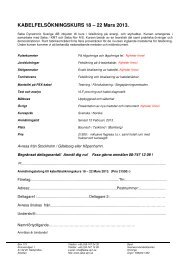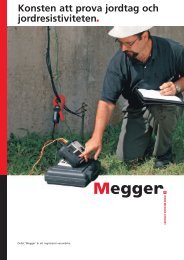A practical guide to earth resistance testing - Weschler Instruments
A practical guide to earth resistance testing - Weschler Instruments
A practical guide to earth resistance testing - Weschler Instruments
Create successful ePaper yourself
Turn your PDF publications into a flip-book with our unique Google optimized e-Paper software.
Treatment of the Soil: Chemical treatment of soil is a good way <strong>to</strong><br />
improve <strong>earth</strong> electrode <strong>resistance</strong> when you cannot drive deeper ground<br />
rods because of hard underlying rock, for example. It is beyond the<br />
scope of this manual <strong>to</strong> recommend the best treatment chemicals for<br />
all situations. You have <strong>to</strong> consider the possible corrosive effect on the<br />
electrode as well as EPA and local environmental regulations. Magnesium<br />
sulfate, copper sulfate, and ordinary rock salt are suitable noncorrosive<br />
materials. Magnesium sulfate is the least corrosive, but rock salt is cheaper<br />
and does the job if applied in a trench dug around the electrode (see Fig.<br />
19). It should be noted that soluble sulphates attack concrete, and should<br />
be kept away from building foundations. Another popular approach is <strong>to</strong><br />
backfill around the electrode with a specialized conductive concrete. A<br />
number of these products, like ben<strong>to</strong>nite, are available on the market.<br />
Chemical treatment is not a permanent way <strong>to</strong> improve your <strong>earth</strong><br />
electrode <strong>resistance</strong>. The chemicals are gradually washed away by rainfall<br />
and natural drainage through the soil. Depending upon the porosity of<br />
the soil and the amount of rainfall, the period for replacement varies. It<br />
may be several years before another treatment is required.<br />
Fig. 19: Trench method of soil treatment 10<br />
Chemical treatment also has the advantage of reducing the seasonable<br />
variation on <strong>resistance</strong> that results from periodical wetting and drying out<br />
of the soil. (See curves of Fig. 20.) However, you should only consider this<br />
method when deep or multiple electrodes are not <strong>practical</strong>.<br />
See Appendix I which describes the use of a nomograph relating length of<br />
rod, diameter of rod, and <strong>earth</strong> resistivity <strong>to</strong> <strong>earth</strong> <strong>resistance</strong>.<br />
Fig. 20: Chemical treatment of soil lessens seasonal variation of electrodes’<br />
<strong>earth</strong> <strong>resistance</strong> 11<br />
10, 11 Source: Reference 20 (page 77)<br />
40 1-866-254-0962 www.megger.com Getting Down <strong>to</strong> Earth 41




